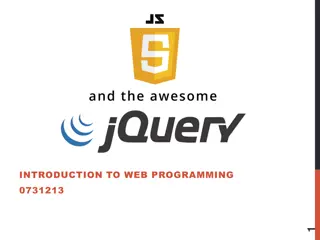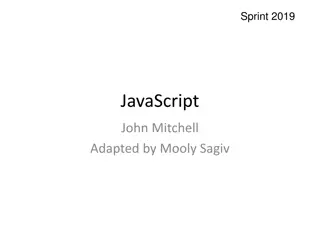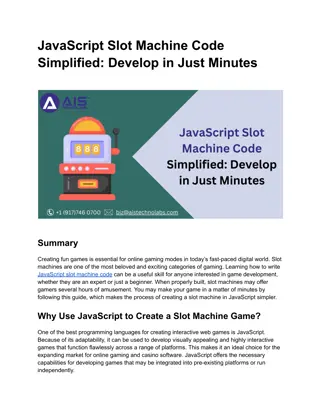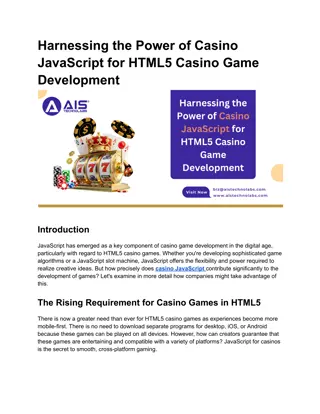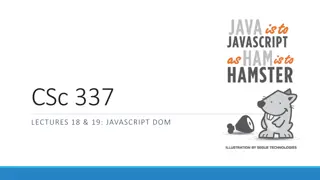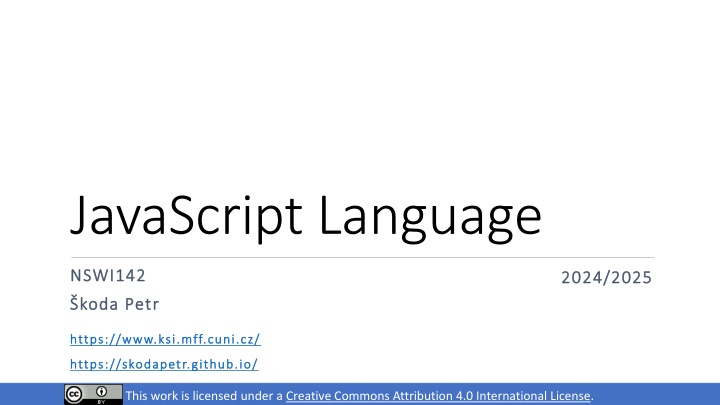
JavaScript Scope and Variables
Explore the intricacies of JavaScript scope and variable declarations, including hoisting, closures, and global vs. local scopes. Learn how these concepts impact your code execution and how to leverage them effectively in your projects.
Download Presentation

Please find below an Image/Link to download the presentation.
The content on the website is provided AS IS for your information and personal use only. It may not be sold, licensed, or shared on other websites without obtaining consent from the author. If you encounter any issues during the download, it is possible that the publisher has removed the file from their server.
You are allowed to download the files provided on this website for personal or commercial use, subject to the condition that they are used lawfully. All files are the property of their respective owners.
The content on the website is provided AS IS for your information and personal use only. It may not be sold, licensed, or shared on other websites without obtaining consent from the author.
E N D
Presentation Transcript
JavaScript Language NSWI142 NSWI142 2024/2025 2024/2025 koda Petr koda Petr https://www.ksi.mff.cuni.cz/ https://www.ksi.mff.cuni.cz/ https://skodapetr.github.io/ https://skodapetr.github.io/ This work is licensed under a Creative Commons Attribution 4.0 International License.
DISCLAIMER Boring Boring is good Boring Boring means your safe good safe.
Global variables Global variables are properties of the global object ( window / globalThis ). Variables can be removed using delete operation. // Following are "equal". a = 123; window.a = 123; var a = 123; // This also impact the scope. for (index of [1,2]) {}; console.log(index); Prints "2" // The scope is in fact global! function funFunction() { if (2 > 4) { var variable = 1; } console.log(variable); } // Remove "a" from global scope. delete a; 4
"var" keyword var-declared variables are hoisted ( lifted to the top of its function/global scope). console.log(x === undefined); // true var x = 3; var x; console.log(x === undefined); // true x = 3; Declaration without value assignment. Variables declared with var are visible in the entire body of function where they were declared. Variables declared outside functions with var are global. Does not work with const/let ( Temporal dead zone (TDZ) ). console.log(x === undefined); let x = 3; Uncaught ReferenceError: x is not defined 5
6 Closure Wiki: A closure is a record storing a function together with an environment.
Scope of variables and functions var a1; // global scope (obj. window in browser) function foo() { let a2; // local scope of foo() function innerFoo() { let a3; // local scope of innerFoo() function innerInnerFoo() { // I can see and use a1, a2, and a3 from here a1 = a2; } } } We follow the scope chain upwards and find the first variable of given name. 7
Demo Closure
Closure function createAdder(x) { return function(y) { return x + y; } } When the inner function is created, the closure captures value of x == 3 "Universal" binding function The Inner function can see variable x due to scoping rules function bindFirst(fnc, x) { return function(y) { return fnc(x, y); } } function add(x, y) { return x + y; } function mul(x, y) { return x * y; } const add3 = createAdder(3); const add7 = createAdder(7); const add3 = bindFirst(add, 3); const mul3 = bindFirst(mul, 3); New function have a new closure where x == 7 add3(14); // is 17 mul3(14); // is 42 add3(10); // is 13 add7(10); // is 17 2025/2026 Example 9
Closure & var let adders = []; for (var i = 0; i < 10; ++i) { adders.push(function (x) { return x + i}); } console.log(adders[0](1)); // ? Outputs 11 let adders = []; for (let i = 0; i < 10; ++i) { adders.push(function (x) { return x + i}); } console.log(adders[0](1)); // ? Outputs 1 let adders = []; for (ver i = 0; i < 10; ++i) { adders.push(function (x) { return x + i}); } i = 41; console.log(adders[0](1)); // ? Outputs 42 10
Closure & objects Objects are passed by a reference. function createMultiplyAndAdd(cfg) { return function(x) { return cfg.mul * x + cfg.add; } } const config = { mul: 2, add: 3 }; const operator = createMultiplyAndAdd(config); operator(42); // is 87 Object modification is visible in closure. config.mul = 3; operator(42); // is 129 11
Object revision Objects are unordered key-value collections, where members are public. New entries can be added dynamically. As functions are first-class citizens, we can add functions as members, mimicking classes. const student = { name: "Ailish", sayHi: function() { console.log(`Hi I'm ${this.name}.`); }, }; 13
Object prototype There are classes since in ES5. There are implemented using prototypes. tile.area(); tile.spam = 42; Searches up the prototype chain, looks for the first area property Creates new property in tile (no prototype chain traversing) tile Square [[Prototype]] side color [[Prototype]] name area() Object.prototype 14
Prototyping const Square = { "side": 0, "perimeter": function() { return 4 * this.side; }, }; // Create as empty object with prototype Square. const tile = Object.create(Square); Prototype object takes the role of a class. // Declare new member on title. tile.side = 42; console.log(tile.perimeter()); // Missing "area" function ? Square.area = function() { return this.side * this.side; } console.log(tile.area()); 15
Classes vs Prototypes Object.prototype Class-based Language JavaScript [[Prototype]] foo const MyClass foo() MyClass foo() [[Prototype]] bar const MySubclass bar() MySubclass bar() [[Prototype]] obj properties myInstance const myInstance 16
Demo Object.create
What is "this"? "this" is a keyword. It is an implicitly declared variable which has different values in different contexts. In global context, outside of a function, "this" refers to the script environment, e.g., window. In function context, "this" value depends on how the function was called. let foo = holder.foo.bind(obj); foo(); this refers to obj this refers to holder holder.foo(); let foo = holder.foo; foo(); foo.apply(thisObject); this refers to global environment this refers to thisObject foo.call(obj); this refers to obj
Constructor Functions Constructor looks / is like an ordinary function. const Circle = function(r) { this.radius = r; }; this refers to the newly created object (so it can be initialized). Creates new object and copies Circle.prototype to internal [[Prototype]] of the new object const myCircle = new Circle(42); The prototype attribute is set to an empty object Circle.prototype.foo = function() { } it can be easily augmented 20
Class Classes: // There are no classes!? class Square { side = 0; class expressions getters / settters constructor() { //.. } static private fields # area() { return 4 * this.side; } }; extends const square = new Square(); square.side = 42; console.log(circle.area()); Advanced Programming of Web Applications - NSWI153 21
Selected functions encodeURI(str) - encode string for URI decodeURI(str) - decode URI to normal string encodeURIComponent(str) - encode string for URL query part parseInt(str, base) - parse textual representation of an integer of given radix parseFloat(str) - parse textual representation of a floating-point number 23
General-purpose Constructors There are wrappers for basic types: Number, String, Boolean, Object, Function. Basic primitives, string, boolean, and number, are automatically converted to their respective wrappers, e.g. when a method is invoked upon them. Wrappers provide additional functionality: Object - manipulation with objects Array - object wrapper for "traditional" arrays Date - time and date information Iterator - implements iterator pattern RegExp - regular expression ... 24
Object Selected Object functions: create(proto, [prop descriptors]) create a new object getOwnPropertyNames(obj) - return an array of property names that are native to obj getPrototypeOf(obj) - get prototype object of obj preventExtensions(obj) - "marks an object as no longer extensible" seal(obj) - "prevent adding/removing of properties" freeze(obj) - "prevent adding/removing/modification of properties" entries() - "returns an array of own enumerable string-keyed property pairs" values() - "returns an array of a given object's own enumerable string-keyed property values" Advanced Programming of Web Applications - NSWI153 25
JSON JSON is a lightweight interchange format for structured data. It is based on subset of JavaScript language. As a format it is language independent. There are parsers and serializers for many languages. JSON was intended for replacing XML in simple scenarios - now most of the web applications. Basic syntax: [ { "StudentId": 42, "Name": "John Smith" }, { "StudentId": 54, "Name": "Jane Johnson", "Graduated": true } ] Two basic structures: collections and lists Supports strings, numbers, bools, and null type Unicode safe // Create object from JSON. const res = JSON.parse(jsonString); // Save object to JSON sring. const jsonString = JSON.stringify(jsObject); Removed: 2022/2023 27
Promise Daniel P. Friedman and David Wise The Impact of Applicative Programming on Multiprocessing. International Conference on Parallel Processing. pp. 263 272, 1976 Available online
Promise and JavaScript A promise represents eventual completion/failure of async. operation, e.g., AJAX request. Promises can be easily chained: .then(function) function called on success .catch(function) function called on error .finally(function) called on completion (success or error) fetch(url).then(response => ) Aggregation: Promise.all([ promise1, promise2, ]) Promise.race([ promise1, promise2, ]) 30
Promises Promises can be easily chained ... that is a good thing, right? asynchAction().then(function(one) { anotherAsync().then(function(two) { thirdAsynch().then(function(three) { // Code here } } } new Promise(function(resolve, reject) { // }) .then(function(result) {/* .. */}) .then(function(result) {/* .. */}) .catch(function(result) {/* .. */}) .then(function(result) { /* .. */ }); ES 2017 comes to the rescue: async function() { const one = await asynchAction(); const two = await anotherAsync(one); const three = await thirdAsynch(two); // Code here } async - function return promise await - wait for promise to be solved catch replaced with try/catch block 31
AJAX A technique that combines three technologies: JavaScript Asynchronous HTTP client API integrated in browser XML or other semi-structured data format Script invokes HTTP transfer by providing URL, method, callbacks, The callback is invoked asynchronously at the conclusion of the HTTP transfer. 33
History var httpReq = new XMLHttpRequest(); If false, the send() call will block (very unwise). httpReq.open("GET", "index.php?ajax=1", true); httpReq.onreadystatechange = function() { if (httpReq.readyState != 4) return; if (httpReq.status === 200) processResponse(httpReq.responseText); else handleError(httpReq.status); } 0 = not initialized, 1 = connection established 2 = headers received 3 = downloading response 4 = operation completed httpReq.send(); XMLHttpRequest also has responseXML property, where the XML DOM is stored. 1998 2015 34
Fetch API New API for AJAX. fetch( input [, init] ) Arguments: input - URL or Request object init - object with initialization parameters method - HTTP method to be used headers - request headers body - request body Instead of a callback fetch utilize promise. 35
Demo Fetch API
ECMA Script WARNING Following examples contain var keyword. The only reason is that it is used in documentation/examples. Still, you should avoid using it as much as possible.
ECMAScript Editions We get a new version every year: ES5 ECMAScript 5 (2009) ES6 ECMAScript 2015 ECMAScript 2016 ECMAScript 2017 ECMAScript 2018 . ECMAScript 2024 (July) The standardization process is public: https://github.com/tc39/proposals/blob/master/finished-proposals.md 38
Ecma TC39 Ecma International, Technical Committee 39 - ECMAScript (Web, GitHub) Standardization process is public, you see it on GitHub. Each proposal is a repository. Each proposal start in stage 0 and aim for Stage 4. Some proposal are implemented before they reach Stage 4. Stages: See for more details. Stage 0 - new Stage 1 - proposal, what, how, why change Stage 2 - described using formal specification language Stage 2.7 - testing and feedback Stage 3 - ready to be accepted Stage 4 - ready to be part of specification 39
ES6: Arrow Functions This is not just a shorthand syntax. Arrow functions are more lightweight, and they bind this at the moment of creation. function foo(x) { return x*x; } // Arrow function const foo1 = (x) => { return x * x; }; // We can omit the return. const foo2 = (x) => x * x; Such behavior is important when passing methods as callbacks. As a result, arrow function are go-to functions for event handlers. // We can omit arg. braces. const foo3 = x => x * x; 41
ES6: Arguments // Default argument values. function inc(val, by = 1) { return val + by; } // Aggregation of remaining arguments. function merge(al, a2, ...restArrays) {} // Spread collection elements as arguments. var coords = [ 1, 2 ,3 ]; // moveBy(1, 2, 3); point.moveBy(...coords); var str = "bar"; // [ 'f', 'o', 'o', 'b', 'a', 'r' ] var chars = [ "f", "o", "o", ...str ]; 42
ES6: Matching // Array matching var list = [ 1, 2, 3 ]; var [ x, y, z ] = list; // var x=1, y=2, z=3 [ z, x, y ] = [ x, y, z ]; // rotate values x,y,z var [ head, ...rest ] = list; // decapitation var a = [ ...arr1, ...arr2 ]; // array concatenation // Object matching var { x, y, z } = get3Dpoint(); var { x: y, y: x, attrs: { depth: z } } = get2Dpoint(); // Context argument matching function avgFirst2([a, b]) { return (a + b) / 2; } function distanceTo({x, y, z = 1}) { } 43
ES6: Functional approach const data = [ 1, 2, 3, 4, 5, 6 ]; for (let i = 0; i < data.length; ++i) { if (data[i] % 2 !== 0) continue; let x = data[i] * data[i]; console.log(x); } Shift in Paradigm const data = [ 1, 2, 3, 4, 5, 6 ]; data.filter(x => x % 2 === 0) .map(x => x * x) .forEach(x => console.log(x)); 44
ES6: Functional approach const traverse = node => (typeof(node) === 'object ? Array.isArray(node) ? node.reduce((acc, val) =>[...acc, ...traverse(val)], []) : [node, ...traverse(Object.values(node))] : []) .filter(({id, command, priority, dependencies}) => id && command && priority !== undefined && dependencies); By Martin Kruli 45
ES6: Exceptions JavaScript is very error-prone language. Yet, errors usually stops current JavaScript code. Error handling is similar to exception catching from other languages. // Handling errors try { ... secured code ... } catch(err) { ... error handling ... } finally { ... finalization code ... } // Throw / create error. throw something; // We can have multiple catch blocks. try {} catch(err if condition) { first handling } catch(err) { ... default... } Regular errors are created by Error constructor. Parameter message with human-readable description. 46
ES2020: ... Optional Chaining to make save function easy. const fooValue = fooInput ? fooInput.value : undefined; const fooValue = fooInput?.value; Nullish Coalescing to provide save default. const text = value.headerText || 'Hello, world!'; const text = value.headerText ?? 'Hello, world!'; 47
ES2024: ... Hashbang Grammar For CLI JS hosts. Change Array by copy Create new array with modification: toSorted, toReversed, toSpliced, with, Support for immutability. const isEven = (number) => number % 2 === 0; const items = [1, 2, 3, 4]; Array find from last items.find(isEven); // 2 items.findIndex(isEven); // 1 items.findLast(isEvent); // 4 items.findLastIndex(isEvent); //3 48
HTML - Living Standard Function structuredClone [*] creates deep copy. let object = { foo: false } let clone = structuredClone(object); console.assert(clone !== original); Stage 0 Proposal for tc39 49
Toolchain None : ) Bundlers Apply transformations and optimizations to JavaScript code (Webpack, Parcel, ). Transpilers Transform new JavaScript to older versions (Babel, ). Advanced Programming of Web Applications - NSWI153 50
Demo Babel.js Try it out

